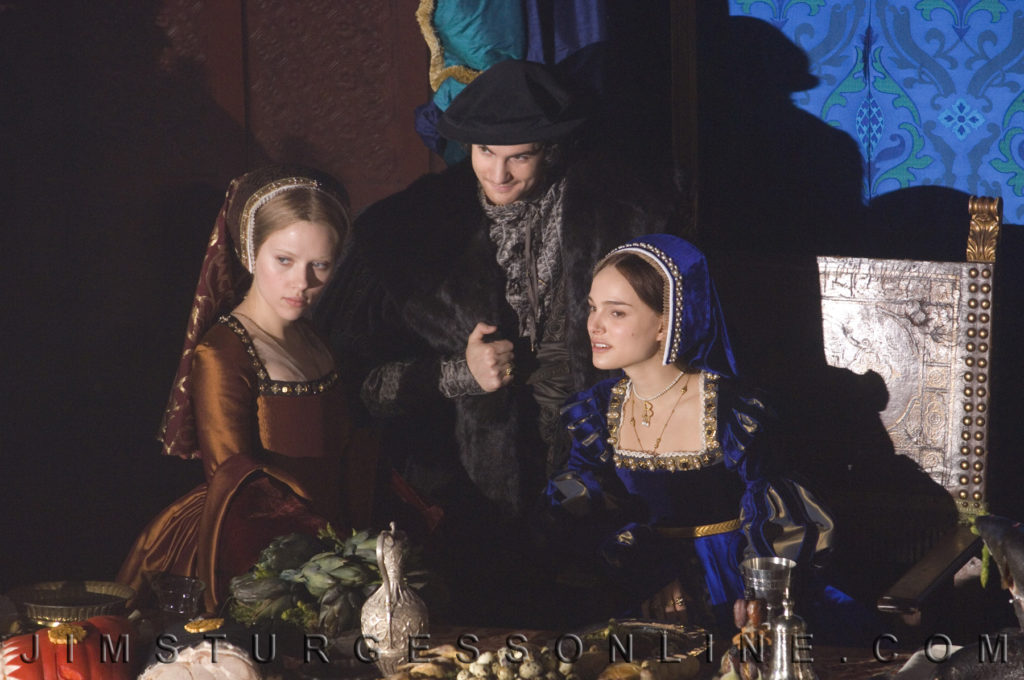
Anne and Mary Boleyn are two young sisters from a fairly well positioned English family in the early 1500s. They’re also both beautiful—a fact that their father, Thomas, is very ready to exploit. As he puts it, “Everyone improves the standing of their family with their daughters.” So he hurriedly weds Mary to a wealthy merchant.
Then Thomas’ brother-in-law, the Duke of Norfolk, shows up with a plan. It seems that the King desperately wants an heir and is more than willing to go outside his marriage bed to get one. Why shouldn’t their family benefit from this royal need? So Thomas, rubbing his hands together in greedy glee, throws young Anne into the mix.
After about three seconds of initial hesitation, Anne decides she favors the idea, especially since it could mean that she’ll eventually be married off to a duke. But the hunky king spots sweet, innocent Mary instead and the family’s plans quickly change. Henry appoints Mary as one of Queen Katherine’s ladies-in-waiting, then gives a prestigious position at court to her hapless husband before abruptly pulling the lovely Boleyn blonde into his bed.
This, of course, causes a bitter rivalry between the two sisters, and Anne is sent (exiled) to France to cool off. Time passes, Henry is very happy with his new lover and the Boleyn family prospers. But when Mary is bedridden with the king’s child, Thomas and Norfolk must figure out a way to keep the king’s attention off all the other young beauties in London. So they send for Anne.
Anne returns from France with her sights set much higher than simply being Henry’s mistress. Not only will she replace Mary and any other of the king’s sexual playthings … she’ll replace the queen.
Although Anne is eager to play her father’s game of sex and ambition, Mary would much prefer a simple life with a loving husband. She says, “I want a husband who loves me—who thinks of me first thing in the morning and the last thing at night.”
Mary is also loyal to her sister, even after she’s been betrayed by her. Hearing that Anne is to be put to death, Mary risks her own life by rushing to the king to plead for her sibling. The king states that Mary is one of the only people he can trust. (He’s somewhat mistaken, though. More on that in “Other Negative Elements.”)
The girls’ mother, Lady Elizabeth, complains that her daughters are being “treated like chattel” and calls for her husband to protect them.
Anne is asked by Henry what makes a great man and she lists humility, generosity and forgiveness (even though none of those attributes seem evident in the king). Though Henry is unfaithful, it seems that Queen Katherine does everything in her power to love her husband and be a good wife to him. “I have been a true obedient wife—as God is my witness!” she states.
England breaks away from the Catholic Church in Rome and forms its own Church of England because of Henry’s determination to divorce Katherine of Aragon and wed Anne. But if you blink, you’ll miss it. The movie spends all of a minute mentioning this monumental decision.
Religious symbols are given screen time and the name of God is evoked in several scenes, however. Statements of, “You cannot undo what has been done before God,” “You want me to lie before God … I will not,” “May God bless you,” “I beseech Jesus to save my master” and a tearful “Sweet Jesus!” are peppered throughout the dialogue—though none of the characters have any apparent personal connection to a Heavenly Father.
That doesn’t stop a man from praying incoherently before his execution. And Anne is seen praying once, too, but her supplication appears to be little more than a means of arousing the king. After reports that Anne has turned to incest, her inquisitors claim that she was “seduced by the devil.”
When referring to the seamy situation that her daughters are in, Lady Elizabeth says, “God, He turned His back on this long ago.” She also asks, “When was it that people stopped thinking of ambition as a sin and started thinking of it as a virtue?”
Anne shuffles Tarot cards as she prepares to read the king’s fortune.
We see several shots of Mary and Henry in bed. The scenes aren’t explicit, but they are quite intimate. They kiss passionately. Once, he’s shirtless and lies on top of her. (She’s dressed in a sleeping gown.) Elsewhere, they cavort or sleep with covers strategically placed. We see bare torsos and backs, and some sexual movements.
Much more significant—and disturbing—are images of rape and contemplated incest. In a panic, Anne tries to convince her brother to have sex with her so that she can fool Henry into believing it’s his child. The two climb into bed, and Anne begins to unbutton his undershirt, but both break down, shaking and crying, and don’t proceed any further.
Angry with Anne for not giving herself to him, Henry finally loses patience, rips her gown and undergarments, and forces himself on her. The camera watches her crying and observes his sexual motions. (The two remain fully dressed.) Much later, Anne tells her sister that she must resort to “degrading things” to arouse Henry.
Mary’s back is exposed to the camera while bathing and we’re shown a partially obscured side view of her breast. We see Mary and her husband on their wedding night as he climbs on top of her. (They’re both in sleeping gowns.) Anne is also shown, with covers pulled up, lying on the bare chest of a man she just married.
Cleavage is revealed by women in their period dresses. Conversations sometimes revolve around the king’s frequent trysts. For example, after Mary’s first night with Henry, the Duke of Norfolk calls her into the room with her husband, mother and father present, and asks, “Well, did he have you?” “More than once?” “Was he satisfied?” And as cruel as that kind of interrogation may be, it’s Anne and Mary’s father who should really be branded with a scarlet letter. He’s openly and repeatedly willing to pimp his daughters for personal gain—with no regrets.
Besides the rape, two primary characters are beheaded. (History buffs just might be able to guess who they are.) We don’t see the blades contacting flesh, but we see them swing and hear the resulting cuts and thumps of the heads. In one case we see a distant shot of a prone body and a pool of blood around a severed head.
The King has gouges and scrapes on his arm and hand after an off-camera riding accident. Lady Elizabeth slaps her husband across the face—hard.
There are three uses each of the words “d–n” and “b–tard.” God’s name is misused several times.
In the course of celebrations and dinners, people drink wine. Henry pours and drinks wine on a few occasions, as does the duke.
In vouching for her sister, Mary lies to the king about Anne’s previously consummated marriage. Henry yells at his court about the queen, “I need to be rid of her—find a reason!” Both Boleyn girls are repeatedly referred to as “whores” or as “whoring” with a public adulterer.
The story of King Henry VIII and his second wife, Anne Boleyn, is a favorite of Hollywood because of its 16th century tangle of royal court intrigues, feverish passions, political machinations, religious wars and callous betrayals.
This particular version of the tale is based on an award-winning Philippa Gregory novel. The movie was scripted by well-known screenwriter Peter Morgan (who is also responsible for The Queen and The Last King of Scotland), and it stars the gifted actresses Natalie Portman and Scarlett Johansson.
But in spite of all this glorified grist for the film-making mill—and in spite of towers, crowns, dukes and royal puffery—there is almost nothing to like about The Other Boleyn Girl. It revels in incest, rape and adultery while simplifying history to its basest form. (And sometimes flagrantly changing it to suit its nasty needs.) Characters are not so much people as they are well-costumed pictures cut from the cardboard covers of dime-store Harlequin novels.
England’s separation from the Church of Rome is shunted aside as an afterthought. Court politics are ignored altogether. And any feelings that might resemble love or devotion are reduced to the hothouse level of lust, jealousy and deception.
Who knows, this whole sordid mess may actually have some similarity to the historical world of the Tudors. After all, “the heart is deceitful above all things, and desperately wicked: who can know it?” reads Jeremiah 17:9. But even if it does mirror then, that by no means makes it any less seedy, morally empty or deliberately titillating now.


After spending more than two decades touring, directing, writing and producing for Christian theater and radio (most recently for Adventures in Odyssey, which he still contributes to), Bob joined the Plugged In staff to help us focus more heavily on video games. He is also one of our primary movie reviewers.
Our weekly newsletter will keep you in the loop on the biggest things happening in entertainment and technology. Sign up today, and we’ll send you a chapter from the new Plugged In book, Becoming a Screen-Savvy Family, that focuses on how to implement a “screentime reset” in your family!